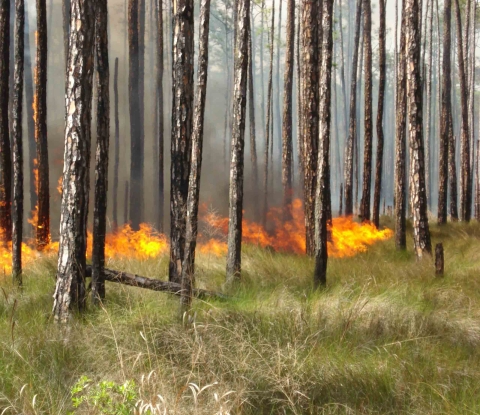What We Do
Wildlife conservation is at the heart of what we do. It drives the work we do on lands and waters managed within the National Wildlife Refuge System, from the purposes for which a refuge is established, to the recreational activities offered, to the resource management tools used. Using conservation best practices, the Refuge System manages Service lands and waters to help ensure the survival of native wildlife species. Our staff use a variety of resource management techniques to maintain, recover or enhance plants and wildlife and the habitats they rely on. Prescribed burning and controlling invasive species invasive species
An invasive species is any plant or animal that has spread or been introduced into a new area where they are, or could, cause harm to the environment, economy, or human, animal, or plant health. Their unwelcome presence can destroy ecosystems and cost millions of dollars.
Learn more about invasive species are key ways we help native plants and wildlife to thrive on the refuge.
Prescribed Fire
Prescribed fire mimics formerly naturally occurring disturbance by fire within refuge habitats. Burning at the refuge helps to maintain plant and wildlife diversity and abundance and is conducted in accordance with a Fire Management Plan.
Invasive species Management
Introduced species degrade, change or displace native habitats and compete with indigenous plants and wildlife. Monitoring and control of harmful introduced species using best management practices is an integral part of refuge management.
Nest Boxes
While visiting the refuge you may notice wood duck nesting boxes. Wood ducks need cavities for nesting. With a loss of mature forest in the region, artificial nesting cavities help support this species.
Management and Conservation
A range of forest management activities occur in the refuge's upland areas. Forest areas may be replanted, thinned, or burned to maintain optimal wildlife habitat. Refuge staff restore historic conditions of open pine savannas in upland areas by using prescribed fire to help regenerate longleaf pine with savannah grass understory habitat. This once common longleaf pine ecosystem supports rich biodiversity, including the threatened gopher tortoise.
Our Projects and Research
Prescribed Fire
Prescribed fire supports new nutrient-rich grasses and restores historical habitat conditions for longleaf pine forests in the refuge’s upland areas. We use prescribed fire at the refuge to provide foraging habitat for the threatened gopher tortoise. The tortoise needs low grassy ground cover to thrive - prescribed burning fosters this type of vegetation. The gopher tortoise is considered a “keystone species,” as its burrows provide shelter for many other species. It’s found in the dryer upland pine forests of the refuge. Historically, southeast gopher tortoises roamed the once common, fire-maintained, longleaf pine forests of this region. The refuge manages about 1000 acres of upland habitat by using controlled fire to maintain this now uncommon grassy pine forest habitat and the tortoise.
Gulf Sturgeon Research
This “living dinosaur” can reach lengths of up to nine feet and weigh up to 300 lbs. The Gulf sturgeon spends much of its life in freshwater, but adult sturgeon typically migrate to feed in rich saltwater bays and estuaries in the fall, returning to their home river system in the spring to spawn. The Gulf sturgeon is listed as a federally endangered species and efforts are underway to understand this animal and conserve its habitat. We collaborate with Louisiana Department of Fish and Wildlife to study the population and movements of Gulf sturgeon in the Pearl River.
Law Enforcement
The U.S. Fish and Wildlife Service maintains a law enforcement presence on National Wildlife Refuge lands for wildlife and public safety. Our refuge law enforcement officers protect fish, wildlife, plants and other natural, cultural and historic resources by fostering understanding and instilling in the visiting public an appreciation of refuge resources, laws, and regulations.
Laws and Regulations
All plants and wildlife are protected on National Wildlife Refuges (NWR), including Bogue Chitto National Wildlife Refuge, unless specific refuge hunting or fishing regulations allows take. Hunting, fishing, and other forms of recreation, where and when allowed, are carefully managed to provide sustainable natural resources and to provide for public safety.




